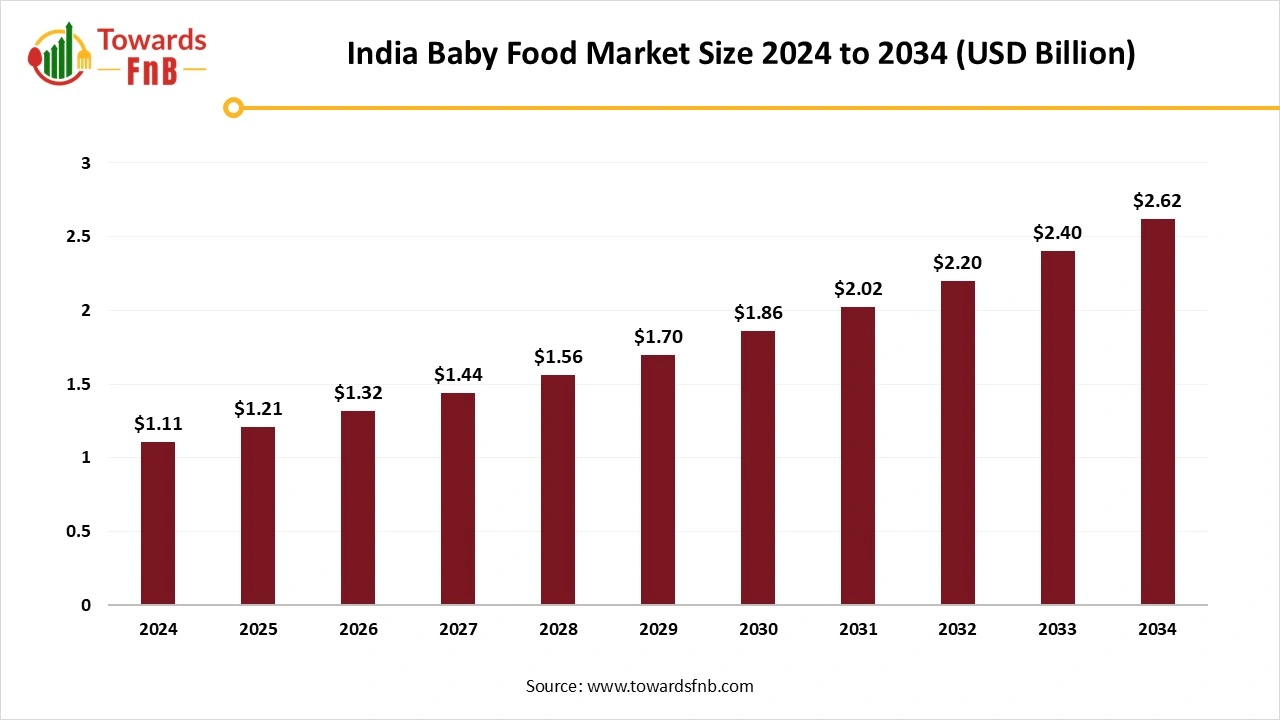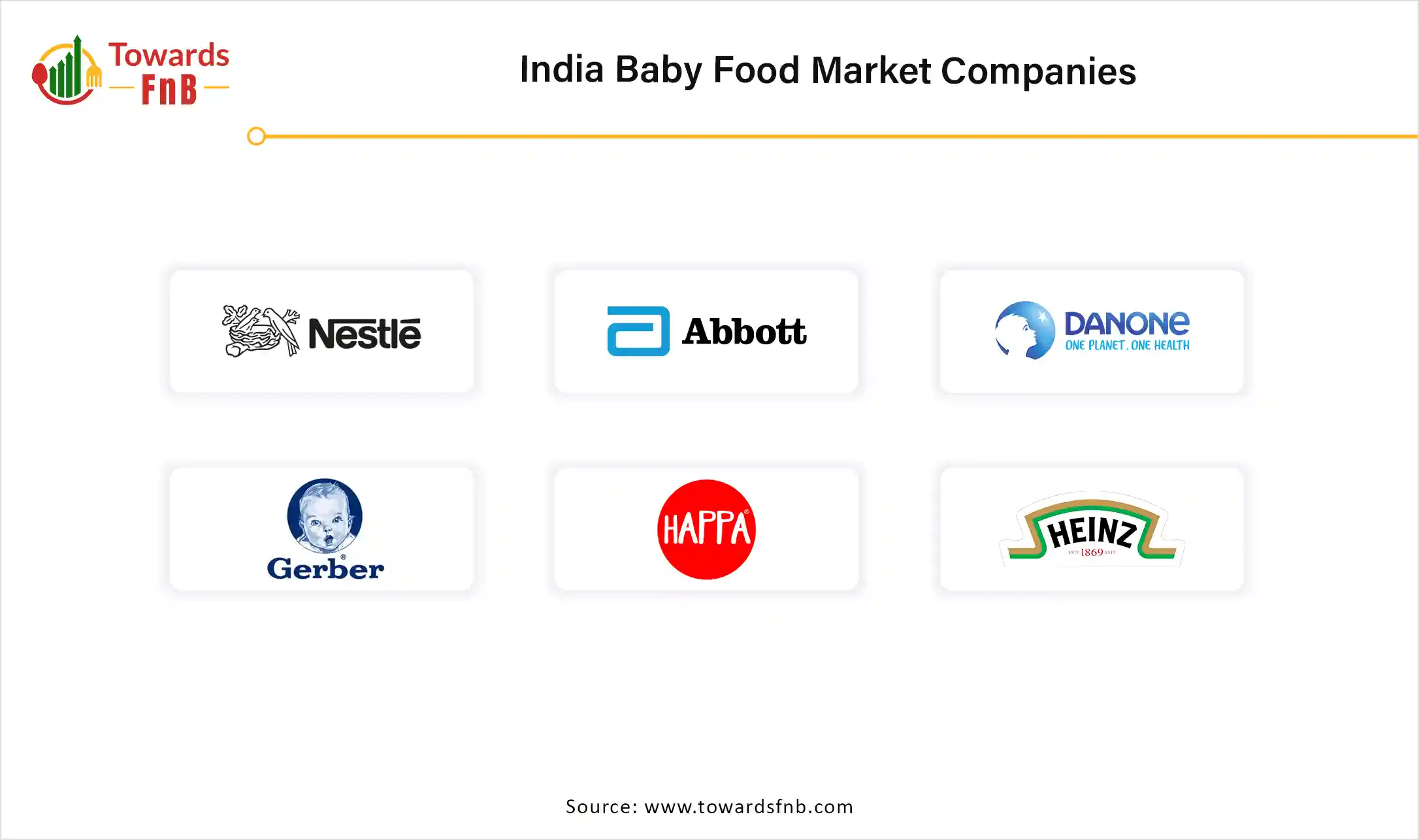November 2025
The India baby food market size reached at USD 1.11 billion in 2024 and is anticipated to increase from USD 1.21 billion in 2025 to an estimated USD 2.62 billion by 2034, witnessing a CAGR of 8.95% during the forecast period from 2025 to 2034. The professional and development standards for baby foods in India enhance trust, transparency, and accountability in baby food businesses.

| Study Coverage | Details |
| Growth Rate from 2025 to 2034 | CAGR of 8.95% |
| Market Size in 2025 | USD 1.21 Billion |
| Market Size in 2026 | USD 1.32 Billion |
| Market Size by 2034 | USD 2.62 Billion |
| Base Year | 2024 |
| Forecast Period | 2025 to 2034 |
The India baby foods market is driven by the positive impact of breastfeeding, baby formula, and other baby food solutions on maternal and infant health. The strengthening of the healthcare ecosystem is supported by the production, marketing, selling, and adoption of baby food products by health-conscious parents. Parents and caregivers are empowered to make informed decisions for their babies by supporting a regulatory environment. Parents are becoming more aware of healthy food options as the principal form of nutrition for their babies.
The Baby Formula Marketing Strategies of Danone SA
| Sr. No. | Baby Formula | Product Category | Age Target |
| 1 | Infant Formula | Infant Formula for young infants | 0-6 months |
| Infant Formula for older infants (Follow-On Formula) | 6-12 months | ||
| 2 | Young Child Formula | Young Child Formula (GrowingUp Milks) | 12-36 months |
(Source: Danone Baby Formula)
The Food Safety and Standards Authority of India (FSSAI) is dedicated to ensuring the availability of safe food products for people from across the globe. It conducts regular surveillance, inspection, monitoring, and random sampling of food products to achieve compliance with the quality and safety parameters. In December 2024, the FSSAI reported the launch of special festive drives to fight against challenges associated with adulteration in sweets, milk, and other food products in the season of holidays. It also conducts improved quality monitoring of food products for infants and the entire public.
The major concerns in India are associated with food contamination, food adulteration, insufficient labeling of food products, and misleading claims. The products need to undergo strict quality control testing to avoid the presence of harmful chemicals, pesticides, excessive sugar, pathogens, or heavy metals during production stages. This will reduce the risk of developing serious health conditions for infants. The misleading claims about the nutritional content and health benefits of food products can create complications in parental decision-making. The gaps in the regulatory framework and enforcement for infant food safety in India can also impose potential challenges in front of the infant food industry or the India baby foods market.
India is committed to the health of infants and children through the implementation of the Infant Milk Substitutes (IMS) Act. The IMS Act focuses on the regulation of the production, supply, and distribution of feeding bottles and infant foods. The Hon'ble Prime Minister of India launched one of the schemes known as the ‘Poshan Abhiyaan’ to focus on the nutritional status of pregnant women, lactating mothers, adolescent girls, and children from 0 to 6 years of age. This program aims to prevent and reduce stunting growth in children aged 0–6 years. It also focuses on preventing and reducing under-nutrition in children aged 0–6 years. The other main objectives of this program are to reduce the incidence of anemia among young children aged 6–59 months, reduce the cases of anemia among women and adolescent girls aged 15–49 years, and reduce low birth weight. It is predicted that India may raise the bar for baby foods to European standards.
The Department of Biotechnology (DBT) and the Ministry of Science and Technology, the Government of India, set the vision for public health and nutrition, including women and child health. The DBT is dedicated to developing technological and clinically-proven solutions to resolve challenges associated with public health nutrition such as malnutrition, stunting, anemia, etc.
Major Achievements of the Department of Biotechnology through Supportive Programmes for Public Health Nutrition and Women and Child Health
How Organic Segment Dominated the India Baby Foods Market in 2024?
The organic segment dominated the India baby foods market in 2024. Organic baby food is in high demand to nourish the future of babies because it is grown without the use of pesticides, genetically modified organisms, chemicals, artificial fertilizers, and radiation. Organic farming methods allow water conservation, pollution reduction, and improved quality of soil and water, due to which organic food is planet-friendly in nature. Consumers choose organic baby food to avoid toxins and harmful chemicals by adopting nutrient-rich and vitamin-packed food for babies. These foods cause lower risks of allergies, offer stronger immunity, prevent obesity, and support long-term health. These foods are available in varieties with a better taste for consumers.
The Conventional Segment is Expected to Grow at the Fastest CAGR in the India Baby Foods Market During the Forecast Period.
The modernized methods of agriculture involve conventional baby food production, which uses pesticides, synthetic fertilizers, and herbicides. The conventional methods are also associated with the production of baby food packaging materials and transportation of ingredients.
What Made Milk Formula the Dominant Segment in the India Baby Foods Market in 2024?
The milk formula segment dominated the India baby foods market in 2024. The milk formula or baby formula feeding presents several benefits, such as convenience, flexibility, time, frequency of feeding, and diet. The milk formula feeds are enriched with proteins, sugars, fats, and vitamins that provide a good nutritional alternative. The baby formula feeding is helpful for babies whose mothers are taking medications and dealing with certain health conditions.
The Ready-to-Eat Baby Food Segment is Expected to Grow at the Fastest CAGR in the Market During the Predicted Timeframe.
The ready-to-eat baby food is enriched with grains, lean proteins, fresh fruits and vegetables, which make it healthy and nutritious. The availability of various types of ready-to-eat food, such as infant cereals, purées, and snacks for infants, provides them with a good source of iron and nutrients. The benefits of these foods are timesaving, convenience, nutrition, and improved mental health.
How did the Supermarkets/Hypermarkets Segment Dominate the India Baby Foods Market in 2024?
The supermarkets/hypermarkets segment dominated the India baby foods market in 2024. The unique features of hypermarkets such as good accessibility, long operating hours, parking space, increased checkout points, and bulk storage offer good customer service. The benefits include convenience, an extensive product range, lower prices, self-service shopping, promotions, and offers. Parents can buy food products for their babies at a one-stop-shop and of diverse varieties by accessing supermarkets nearby to them.
The Online Retail Stores Segment is Expected to Grow at the Fastest CAGR in the Market During the Forecast Period.
The online retail shops offer better prices, fewer crowds, and time for consumers. They also offer flexible payment options and customers can purchase products from home. Online retailers can reach up to a global customer base by selling products over the internet without the need for a vast network of physical stores.
Nestle SA
Danone India

By Category
By Product Type
By Distribution Channel
November 2025
November 2025
November 2025
November 2025